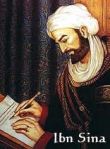 Ibn Sina was born in 980 C.E. at Afshana near Bukhara. The young Bu Ali received his early education in Bukhara, and by the age of ten had become well versed in the study of the Qur’an and various sciences. He started studying philosophy by reading various Greek, Muslim and other books on this subject and learnt logic and some other subjects from Abu Abdullah Natili, a famous philosopher of the time. While still young, he attained a degree of such expertise I medicine that his renown spread far and wide. At the age of 17, he was fortunate in curing Nooh Ibn Mansoor, the King of Bukhara, of an illness in which all the well-known physicians had given up hope. On his recovery, the King wished to reward him, but the young physician only desired permission to use his uniquely stocked library.
Ibn Sina was born in 980 C.E. at Afshana near Bukhara. The young Bu Ali received his early education in Bukhara, and by the age of ten had become well versed in the study of the Qur’an and various sciences. He started studying philosophy by reading various Greek, Muslim and other books on this subject and learnt logic and some other subjects from Abu Abdullah Natili, a famous philosopher of the time. While still young, he attained a degree of such expertise I medicine that his renown spread far and wide. At the age of 17, he was fortunate in curing Nooh Ibn Mansoor, the King of Bukhara, of an illness in which all the well-known physicians had given up hope. On his recovery, the King wished to reward him, but the young physician only desired permission to use his uniquely stocked library.
On his father’s death, Bu Ali left Bukhara and travelled to Jurjan where Khawarizm Shah welcomed him. There, he met his famous contemporary Abu Raihan al-Biruni. Later he moved to Ray and then to Hamadan, where he wrote his famous book Al-Qanun fi al-Tibb. Here he treated Shams al-Daulah, the King of Hamadan, for severe colic. From Hamadan, he moved to Isphahan, where he completed many of his monumental writings. Finally, he returned to Hamadan where he died in 1037 C.E.
He was the most famous physician, philosopher, encyclopedist, mathematician and astronomer of his time. His major contribution to medical science was his famous book al-Qanun, known as the “Canon” in the West. He was also the first to describe meningitis and made rich contributions to anatomy, gynecology and child health.
His philosophical encyclopedia Kitab al- Shifa was a monumental work, embodying a vast field of knowledge from philosophy to science. He classified the entire field as follows: theoretical knowledge: physics, mathematics and metaphysics; and practical knowledge: ethics, economics and politics.
Ibn Sina also contributed to mathematics, physics and music. In physics, his contribution comprised the study of different forms of energy, heat, light and such concepts as force, vacuum and infinity. He made the important observation that if light is due to the emission of some sort of particles by the luminous source, the speed of light must be finite. Besides Shifa his well-known treatises in philosophy are al-Najat and Isharat.
Related articles
- Ibn Sina (Avicenna) (973-1037): On Medicine, c. 1020 CE By H.Mustafa (dinalislam1.wordpress.com)
- When did Science begin? (scientificgems.wordpress.com)
